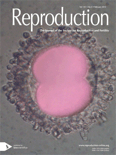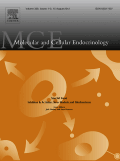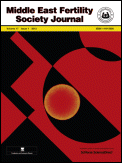
REPRODUCTION
Scope & Guideline
Exploring the frontiers of reproductive science.
Introduction
Aims and Scopes
- Reproductive Physiology and Endocrinology:
Research investigating the hormonal and physiological mechanisms governing reproduction in various species, including studies on the roles of hormones like estrogen, progesterone, and testosterone in reproductive functions. - Embryonic Development and Stem Cell Biology:
Exploration of early developmental processes, including oocyte maturation, fertilization mechanisms, and embryonic stem cell differentiation, with emphasis on the molecular and cellular pathways involved. - Reproductive Toxicology and Environmental Influences:
Studies assessing the impact of environmental chemicals and lifestyle factors on reproductive health, including the effects of endocrine disruptors on fertility and developmental outcomes. - Age-related Reproductive Changes:
Investigating the biological and physiological changes associated with reproductive aging in both males and females, including studies on fertility decline and mechanisms underlying age-related reproductive disorders. - Assisted Reproductive Technologies (ART):
Research focusing on advancements in ART techniques such as in vitro fertilization (IVF), somatic cell nuclear transfer (SCNT), and other methods aimed at improving reproductive outcomes. - Comparative Reproductive Biology:
Comparative studies across different species to understand reproductive mechanisms and challenges, including models in livestock and wildlife, to inform conservation and agricultural practices.
Trending and Emerging
- Impact of Environmental Factors on Reproductive Health:
There is a growing emphasis on understanding how real-life environmental exposures, such as pollutants and endocrine disruptors, affect reproductive health, reflecting heightened awareness of environmental issues. - Integrative Studies on Reproductive Aging:
Recent publications show an increasing trend in studies addressing reproductive aging, particularly the metabolic and inflammatory pathways influencing fertility in aging populations. - Advancements in Assisted Reproductive Technologies (ART):
Research focused on improving ART techniques, including innovations in embryo culture and cryopreservation methods, has gained momentum, driven by the need for enhanced reproductive outcomes. - Role of Microbiomes in Reproductive Health:
Emerging research highlights the influence of microbiomes on reproductive health, particularly in relation to pregnancy outcomes and fertility, indicating a shift toward understanding holistic health factors. - Molecular Mechanisms in Embryonic Development:
An increasing number of studies are delving into the molecular and genetic underpinnings of embryonic development, with a focus on epigenetics and cellular signaling pathways.
Declining or Waning
- Traditional Veterinary Reproductive Studies:
Research focusing on conventional veterinary reproductive practices and outcomes has decreased, possibly due to the shift towards more integrative and molecular approaches in reproductive biology. - Basic Genetic Studies without Clinical Relevance:
Papers that focus solely on fundamental genetic mechanisms without direct implications for reproductive health or clinical applications are appearing less frequently, reflecting a trend towards translational research. - Reproductive Health in Non-Human Models:
There appears to be a waning interest in studies focused solely on reproductive health in non-human models, as researchers increasingly seek to draw connections to human health issues or applied agricultural significance.
Similar Journals

Reproduction and Fertility
Innovating research in reproductive medicine.Reproduction and Fertility is a premier academic journal published by BIOSCIENTIFICA LTD, dedicated to advancing knowledge in the fields of reproductive sciences, obstetrics, gynecology, and related areas. Established with a focus on delivering high-quality research, this journal has quickly ascended in prominence, achieving a commendable Q2 ranking in multiple categories, including Embryology, Obstetrics and Gynecology, Reproductive Medicine, and Urology, as of 2023. With an E-ISSN of 2633-8386, Reproduction and Fertility aims to provide a valuable platform for researchers, professionals, and students alike, offering insights into the latest discoveries and innovations in reproductive health. Although currently not an open-access journal, it remains committed to disseminating important findings that can influence clinical practices and policy-making worldwide. Operating from its headquarters in Bristol, United Kingdom, the journal serves as an essential resource for anyone invested in understanding and improving reproductive health outcomes through rigorous academic research.

REPRODUCTIVE TOXICOLOGY
Illuminating the effects of toxicants on reproductive systems.REPRODUCTIVE TOXICOLOGY, published by Pergamon-Elsevier Science Ltd, stands as a pivotal journal in the field of toxicology, specifically focusing on the effects of environmental and pharmaceutical agents on reproductive health. Established in 1987, the journal has a rich history of contributing to the scientific community, and it continues to publish rigorous research and reviews that illuminate the intricate relationships between various toxicants and their reproductive impacts. With an impressive 2023 Q2 ranking in Toxicology and a Scopus ranking of #42 out of 133 in the Toxicology category, REPRODUCTIVE TOXICOLOGY emphasizes high-quality scholarly work that influences both academia and industry practices. Researchers, professionals, and students in toxicology, pharmacology, and public health will find this journal an invaluable resource for staying informed on the latest findings and methodologies in reproductive toxicology. While the journal currently adheres to traditional publishing models without open access options, its authoritative content remains accessible to a global audience interested in advancing the understanding of toxicological impacts on reproduction.

Asian Pacific Journal of Reproduction
Bridging Gaps in Reproductive KnowledgeAsian Pacific Journal of Reproduction is a dynamic open-access journal specializing in a diverse array of topics related to reproduction across various species, including humans, animals, and plants. Published by Wolters Kluwer Medknow Publications, this peer-reviewed journal has been committed to disseminating high-quality research since its inception in 2012. With an accessible ISBN of 2305-0500 and E-ISSN 2305-0519, the journal has rapidly established itself within the academic community, evidenced by its categorization in Q3 and Q4 quartiles across multiple fields, including Obstetrics, Gynecology, and Animal Science. Researchers are encouraged to contribute their findings to foster a deeper understanding of reproductive health and practices in the Asian Pacific region and beyond. The journal's inclusive scope and emphasis on interdisciplinary collaboration make it a crucial platform for professionals and scholars seeking to stay at the forefront of reproductive research.

MOLECULAR AND CELLULAR ENDOCRINOLOGY
Unveiling the complexities of hormones and cellular interactions.MOLECULAR AND CELLULAR ENDOCRINOLOGY, published by Elsevier Ireland Ltd, stands as a pivotal resource in the fields of biochemistry, endocrinology, and molecular biology. With an ISSN of 0303-7207 and E-ISSN of 1872-8057, this esteemed journal has been disseminating significant findings since its inception in 1974 and continues to do so through 2024. Ranked in the Q1 quartile for Biochemistry and Q2 for both Endocrinology and Molecular Biology, it is recognized for its impactful contributions to research, holding impressive Scopus rankings that place it at the forefront of its category. The journal's wide-reaching influence is underscored by its commitment to quality, ensuring that only the most impactful articles advance the understanding of cellular mechanisms and hormonal regulation. Although not open-access, its relevance and rigorous peer-review process make it an essential read for researchers, professionals, and students eager to explore the complexities of endocrinology and biochemistry.

MOLECULAR REPRODUCTION AND DEVELOPMENT
Connecting researchers to advance the science of reproduction.MOLECULAR REPRODUCTION AND DEVELOPMENT is a prestigious peer-reviewed journal published by WILEY, specializing in the intricate domains of Cell Biology, Developmental Biology, and Genetics. Since its inception in 1988, this journal has been a vital platform for disseminating pioneering research and innovative methodologies that advance our understanding of molecular mechanisms driving reproduction and development. With a current impact factor reflective of its significance in the field, MOLECULAR REPRODUCTION AND DEVELOPMENT is ranked Q3 in both Cell Biology and Developmental Biology, and Q2 in Genetics, underscoring its relevance and scholarly contribution. Catering to a diverse audience of researchers, professionals, and students, this journal not only showcases cutting-edge findings but also aims to foster interdisciplinary exchanges that enhance scientific collaboration. By exploring critical biological processes, it ultimately contributes to the broader understanding of health and disease in various organisms, making it an essential resource for anyone dedicated to the life sciences.

International Journal of Fertility & Sterility
Pioneering Research in Fertility and SterilityThe International Journal of Fertility & Sterility, published by ROYAN Institute, is a leading academic platform dedicated to advancing knowledge in the fields of obstetrics, gynecology, and reproductive medicine. With an ISSN of 2008-076X and an E-ISSN of 2008-0778, this Open Access journal has been making significant contributions to the scientific community since its inception in 2007. Based in Tehran, Iran, the journal showcases rigorous research and promotes interdisciplinary collaboration, addressing critical topics related to fertility, sterility, and reproductive health. As of 2023, it holds an impressive Q2 ranking in Obstetrics and Gynecology and a Q3 ranking in Reproductive Medicine, underscoring its relevance and impact in the academic sphere, with Scopus ranks placing it at #67 in Obstetrics and Gynecology and #32 in Reproductive Medicine. The journal's commitment to accessibility and quality is reflected in its global readership, making it an essential resource for researchers, healthcare professionals, and students seeking to enhance their understanding of fertility issues and reproductive technologies.

Plant Reproduction
Innovating Knowledge in Plant Reproductive ProcessesPlant Reproduction is an esteemed academic journal published by Springer, dedicated to advancing the understanding of reproductive processes in plants. With its ISSN 2194-7953 and E-ISSN 2194-7961, this journal serves as a vital resource for researchers and professionals in the fields of cell biology and plant science. Since its inception in 2013, it has been recognized in the Q1 Quartile for plant science, underscoring its significance and impact within the academic community, while maintaining a ranking of #79/516 in the Scopus database for agricultural and biological sciences. The journal embraces an Open Access model, enhancing accessibility for a broader audience of scholars and practitioners. As we continue to converge our research efforts towards 2024 and beyond, Plant Reproduction remains committed to exploring innovative findings and fostering collaboration in plant reproductive biology, thereby contributing significantly to the global understanding of plant systems and their ecological impacts.

Reproductive Biology
Fostering Collaboration in Reproductive ResearchReproductive Biology is a premier academic journal published by Elsevier, dedicated to advancing the field of reproductive science. With an ISSN of 1642-431X and an E-ISSN of 2300-732X, this journal has been serving the scientific community since its inception in 2001. It notably holds a Q1 ranking in Animal Science and Zoology as of 2023, underscoring its significant impact and prominence in this domain. The journal encompasses a wide array of topics surrounding reproductive biology, including but not limited to endocrinology and developmental processes, making it an essential resource for researchers and practitioners. Although it operates under a traditional access model, its comprehensive scope offers valuable insights that contribute to advancements in reproductive health, animal conservation, and biotechnology. Published in the Netherlands, Reproductive Biology aims to foster interdisciplinary collaboration and innovation, ultimately enriching our understanding of reproductive mechanisms across various species. Researchers, professionals, and students alike will find this journal an indispensable platform for disseminating groundbreaking research and engaging with the latest findings in reproductive science.

JOURNAL OF MOLECULAR ENDOCRINOLOGY
Uncovering Breakthroughs in Molecular EndocrinologyJOURNAL OF MOLECULAR ENDOCRINOLOGY, published by BIOSCIENTIFICA LTD, is a prestigious academic journal that has made significant contributions to the fields of endocrinology and molecular biology since its inception in 1988. With an impressive impact factor that places it in the Q1 category for Endocrinology and Q2 for Molecular Biology, this journal is recognized for its rigorous peer-reviewed research that addresses key questions at the intersection of molecular mechanisms and hormonal regulation. The journal's accessibility within the Scopus rankings, notably positioned 45th out of 128 in Endocrinology, highlights its relevance and influence in shaping contemporary scientific discourse. Although the journal does not currently offer open access options, it remains an essential resource for researchers, professionals, and students eager to explore groundbreaking discoveries and advancements in the hormonal sciences. The JOURNAL OF MOLECULAR ENDOCRINOLOGY continues to pave the way for critical exploration and innovation, ensuring its place as a vital publication for the advancement of knowledge in molecular endocrinology.

Middle East Fertility Society Journal
Advancing fertility knowledge for a healthier future.Middle East Fertility Society Journal is a premier open-access publication established in 1996 that caters to the fields of Obstetrics and Gynecology as well as Reproductive Medicine. Published by SPRINGER in Egypt, this journal has made significant strides in disseminating high-quality research and advancements in reproductive health, achieving a 2023 Scopus rank of #102 in Obstetrics and Gynecology and #47 in Reproductive Medicine, placing it in the 51st and 48th percentiles respectively. With an aim to foster collaboration and innovation in the fertility sector, it welcomes researchers and practitioners to share their findings and insights, contributing to the global discourse on reproductive issues. As an open-access journal since 2010, it ensures that the latest research is readily available to a broad audience, enhancing accessibility and knowledge transfer in the vital area of reproductive health.